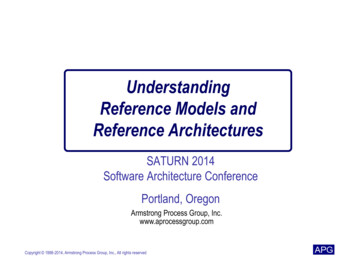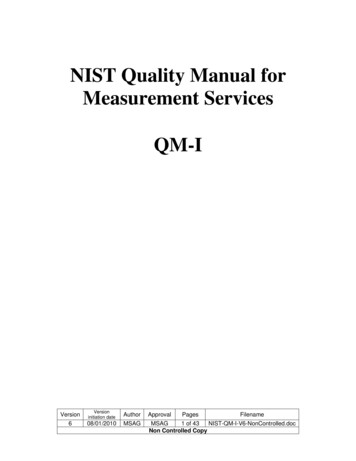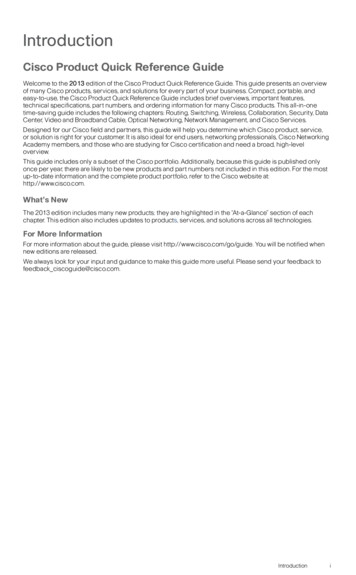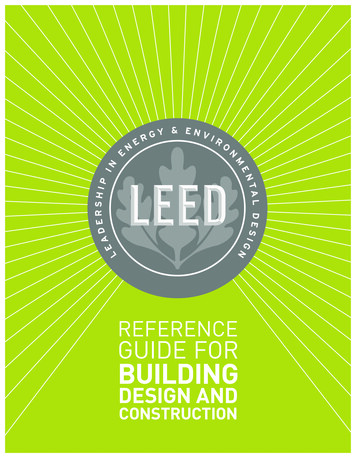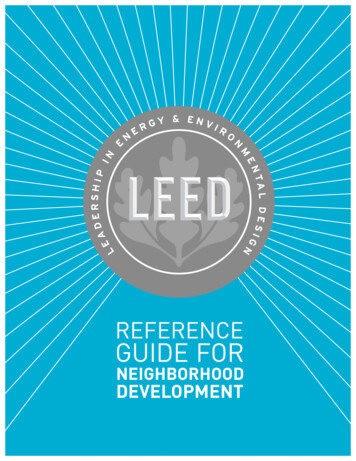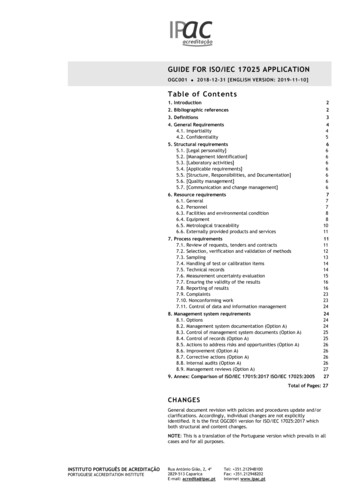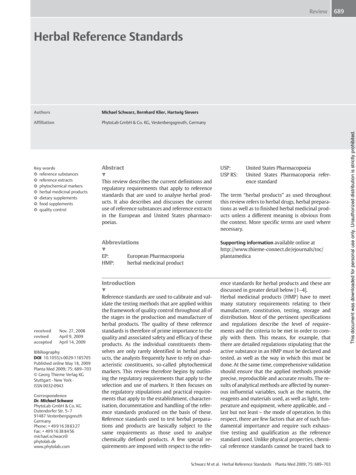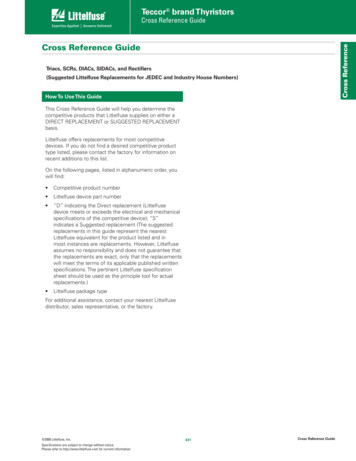
Transcription
The Elsevier Copyediting Specification for AuthorsVersion: 3.2The Complete Reference Guide to the Elsevier CopyeditingSpecification for AuthorsAuthor: Caroline Jones Email: copyeditingspecs@elsevier.comVersion Date: 01 Aug 2019Contents1.2.3.Audience . 3Introduction . 3Reference to other documents . 33.1.3.2.3.3.3.4.4.General issues not covered by this document – Chicago Manual of Style . 3Style guides . 3Dictionaries . 3General style reference for medical and nursing titles . 3Core information . 44.1.Chapter opening pages . 44.1.1. Contributor names and affiliations . 44.2.Variations in English spelling and grammar (UK, US) . 44.3.Basic usage. 44.4.Italics and bold . 54.5.Commas and “that” / “which” . 54.6.Quotes / extracts and single / double quotation marks . 64.7.Capitalization . 64.8.Register marks and trademarks . 64.9.Names of drugs . 74.10. Abbreviated genus names . 74.11. Percent. 74.12. Headings . 74.12.1.Number and ordering of headings . 74.13. Plurals . 74.14. Abbreviations, acronyms, possessives and contractions . 74.14.1.Abbreviations in common usage . 94.15. Numerals . 94.16. Units of measurement . 94.17. Dates and time . 104.18. En dash . 104.19. Em dash . 114.20. Hyphens. 114.21. Geographic references. 124.22. Displayed and run-on (run-in) lists. 124.22.1.Punctuation in run-on lists . 124.22.2.Punctuation in displayed lists . 124.22.3.The use of bullets or numbers for displayed lists . 124.23. Tables and boxes . 134.23.1.Table footnotes . 134.23.2.Data sources and credit lines . 144.23.3.Table body text . 144.23.4.Tables with totals. 144.23.5.Units of measure . 144.24. Figures. 144.24.1.Figure legends: Content . 144.24.2.Style and punctuation . 154.24.3.Sources . 154.24.4.Scale bars . 154.24.5.Halftones . 15 Elsevier1[Click for Contents Page]
The Elsevier Copyediting Specification for AuthorsVersion: 3.24.24.6.Color and colorful e-products . 154.25. Permissions . 154.25.1.Figures . 154.25.2.Tables . 164.26. Footnotes and endnotes . 164.27. Acknowledgments . 164.28. Cross-references . 164.29. The Internet and World Wide Web . 164.30. Religion and politics . 164.31. General terminology . 175.6.Appendices . 185.1.Appendix A: Displayed equations (maths and chemistry) . 185.1.1. Spacing and breaking of equations . 185.1.2. Enumeration . 185.1.3. Delimiters: Parentheses, brackets and braces . 185.1.4. Decimal points . 185.1.5. Fractions . 195.1.6. Text citation of equations . 195.1.7. Greek . 195.1.8. Roman and italic . 195.1.9. Limits of integration . 195.1.10.Limits of summation, product, union, etc . 195.1.11.Multiplication . 205.1.12.Ratios . 205.1.13.Units . 205.2.Appendix B: Equations style sheet checklist . 215.3.Appendix C: Things to clarify with your Elsevier project contact: . 22Reference material . 22 Elsevier2[Click for Contents Page]
The Elsevier Copyediting Specification for Authors1.Version: 3.2AudienceThis document is intended as a reference for Elsevier authors.2.IntroductionThis guide provides a comprehensive set of style rules and guidelines for Elsevier book authors.3.Reference to other documents3.1.General issues not covered by this document – Chicago Manual of StyleFor any general issues (i.e., those not specific to a particular subject area), please refer to The Chicago Manual ofStyle. The most recent edition can be found online at www.chicagomanualofstyle.org.3.2.Style guidesYou may refer to a number of external style guides as agreed with your Elsevier project contact.o AMA Manual of Style (for medical books)o APA Style Publication Manual (for psychology books)o ACS Style Guide (for chemistry books)o AGPS Style Manual (Australian titles only)3.3.DictionariesFor spelling and usage in specific subject areas, reference can be made to various dictionaries as necessary. 3.4.Merriam Webster’s Dictionary (for general terms)Dorland’s Illustrated Medical Dictionary (for medical terms)Dorland’s Dictionary of Medical Acronyms and Abbreviationso Dorland’s contains abbreviations not found in Chicago or AMA, and should only be referred to afterthe other references have been exhausted.General style reference for medical and nursing titles For guidance on aspects of medical texts not covered in this document, please consult, in the first instance,guidelines found in the AMA Manual of Style, followed by Dorland’s Illustrated Medical Dictionary.For SI units and abbreviations in Nursing Titles, adhere to the ISMP’s list of Error-Prone Abbreviations,Symbols and Dose Designations and Lists of Look-Alike Drug Names with Recommended Tall Man Letters. Elsevier3[Click for Contents Page]
The Elsevier Copyediting Specification for Authors4.Version: 3.2Core information4.1.Chapter opening pages4.1.1.Contributor names and affiliationsNames and affiliations should appear in English and in the following form: given name followed by familyname; please check that all names are accurately spelled. Department/division names (if applicable).Institution/organization, city, state/province/territory (for United States/Canada two-letter postal serviceformat, Australia three-letter format), and country (written out in full). For Medical Education, HealthProfessions, Nursing and Specialty Medicine titles, qualifications and academic position/role, may beincluded.John SmithOxford University, Department of Physics, Oxford, United KingdomCharles J.D. WallingfordWyeth Nutrition, Collegeville, PA, United StatesVictor Albert Thompson RN, PHC, NPConestoga Institute of Technology and Advanced Learning, Kitchener, ON, CanadaRoger J. WhitelyThe University of New South Wales, Kensington, NSW, AustraliaNOTE: Qualifications should not be listed for Science and Technology Books unless specifically requestedby your Elsevier project contact. If you are uncertain if your book is an S&T Book please check with your Elsevierproject contact. 4.2.Additional affiliation information such as PO Box, zip/post codes, and email addresses will not be includedunless you have been informed otherwise by your Elsevier project contact.Affiliations should be in the English form (i.e., not in a foreign language) if an English version is in commonusage. For example, use “University of Vienna” rather than “Universität Wien.”US and Australian states and Canadian provinces will be cited in their two or three-letter format if included inthe contributor list, but countries should always be written out in full, i.e., “United Kingdom” and “UnitedStates.”Variations in English spelling and grammar (UK, US) 4.3.You will be advised at the beginning of the project which type of English the project is to follow. If you areunable to deliver your manuscript in the UK/US spelling convention specified please make your Elsevierproject contact aware.Basic usage Use noun and adjective forms correctly:Nouncallusfungusmucusphosphorus Elsevier4Adjectivecallousfungous (or fungal)mucousphosphorous[Click for Contents Page]
The Elsevier Copyediting Specification for Authors 4.4.Version: 3.2Some words have both “-ic” and “-ical” endings, depending on their meaning (e.g., “classic” vs “classical,”“economic” vs “economical,” “historic” vs “historical”). Some authors express a preference for “-ical”endings; if these have been used throughout the text, please confirm with your Elsevier project contact.Italics and bold 4.5.Use of italic or bold for emphasis within the text is discouraged. Italic may be used to introduce new terms,but such use should be kept to a minimum.In all instances, observe the conventions of Latin binomials (italics, cap for genus, lowercase italics forspecies).Use italic for foreign phrases but not those that have become familiar through constant use (e.g., “in situ,”“via”).When labels that appear on a figure are mentioned in a figure footnote, they are set in italic type (e.g., “BP,Blood pressure; RR, respiratory rate; red arrows, air flow”). If a label occurs within a figure legend, it isitalicized and placed within parentheses (e.g., “Superior posterior portion of globe removed, with relationshipof vitreous to disc (arrow) and macula”). See also Figure legends: Content.If terms are styled either italic or bold to denote a glossary inclusion, this should be retained.Commas and “that” / “which” Use of the serial comma (Oxford comma) is mandatory for US English, but not for UK English.UK ENGLISH: If you are a UK author and you use the serial comma consistently, it will not be changed. “That” and “which” are both relative pronouns. In polished American prose, that is used restrictively tonarrow a category or identify a particular item being talked about (e.g., “any building that is taller must beoutside the state”); which is used nonrestrictively: not to narrow a class or identify a particular item but toadd something about an item already identified (e.g., “alongside the officer trotted a toy poodle, which ishardly a typical police dog”). Which should be used restrictively only when it is preceded by apreposition (e.g., “the situation in which we find ourselves”). Otherwise, it is almost always preceded by acomma, a parenthesis, or a dash.Do not use commas in 4-digit numbers except when needed for alignment in tables.Do not use a comma between a figure number and part letter when referring to figures in the text (e.g., “InFig. 4.4B, the arrow ”).Use “who,” not “that” when referring to people.Do not use a comma after introductory words or phrases that do not require a pause:o “thus”o “therefore”o “in 1950”o “in most instances”unless this might lead to misinterpretation.Do use a comma after introductory words or phrases that require a pause:o “however,”o “for example,”o “in addition,”o “namely,”o “nevertheless,”Do not use a comma after a short introductory phrase if the first word of the independent clause begins withan article, but do use the comma if the independent clause begins with any other part of speech:o “In liability insurance agreements the individual ”o “After resting, diabetic patient, ”o “Occasionally, small cuts are made.” (i.e., the cuts are not occasionally small). Elsevier5[Click for Contents Page]
The Elsevier Copyediting Specification for Authors 4.6.Version: 3.2o “Occasionally a small cut is made.”Use a comma after introductory adverbial clauses:o “If rapid improvement does not occur, ”o “When pus is present, ”o “Although the exposure method is more applicable to burns of the trunk, ”Reference numbers and footnote identifiers follow periods and commas but precede colons and semicolons.Quotes / extracts and single / double quotation marks 4.7.Use US style “double” quotation marks, with closing punctuation inside marks and ‘single’ marks for quoteswithin quotes. For Books using UK & Australian English, use ‘single’ quotation marks, with closingpunctuation outside marks (unless it belongs to the quoted material) and “double” marks for quotes withinquotes.All quoted extracts should be carefully transcribed. It is essential that the original punctuation and spelling ofthe extract to be quoted are preserved.Errors within a quoted passage should be corrected and enclosed within brackets.If it is important that errors be retained for sense, acknowledge using “[sic].”All quoted material should be associated with a reference for which full details should be given.Quotes are set as reduced text (i.e., smaller than and indented from main text) when the material is longer thanfour typeset lines. Quotation marks are not used in this instance.Capitalization 4.8.Capitalization should be kept to a minimum and reserved for proper nouns.To avoid complications for the copyeditor in deciding what to capitalize please do not include fullycapitalized headings within the manuscript.For headings in Title Case (i.e., that are main words up), capitalize the first word and all nouns, pronouns,adjectives, verbs, subordinate conjunctions and prepositions of four letters or more. Do not capitalize:o conjunctions such as: “and,” “but,” “or,” “yet,” “for,” “nor,” “so” (unless the conjunction is four ormore letters)o articles: “a,” “an,” “the” (unless it’s the first or last word of the title)o prepositions: “on,” “at,” “to,” “in,” “for,” etc. (unless the preposition is four or more letters and/or it’sthe first or last word of the title).Always capitalize the word “Is” in article titles.Convert the “to” in infinitives to lowercase.When you use the name of a product or a newly coined term, ensure consistency in spelling and capitalization.Use initial capitals for specific features in the book itself (e.g., “Fig. 1.1,” “Table 4.1,” “Chapter 3”).“Figure,” “Chapter,” “Box,” “Plate,” and “Table” should begin with a capital letter only if they appear with anumber.Positions such as “doctor,” “nurse,” or “physiotherapist” are lowercase.Adjectives derived from personal names are normally capitalized. Nouns and adjectives designating culturalstyles, movements and schools and their adherents are capitalized if derived from proper nouns. Those incommon usage can be found in Merriam Webster’s Dictionary. Some words capitalized when used inreference to a school of thought are lowercased when used metaphorically. Personal, national or geographicalnames, and words derived from them, are often lowercased with a nonliteral meaning. See The ChicagoManual of Style for more details and examples.When a sentence begins with a symbol, lowercase Greek letter or number, the next word starts with a capitalletter (e.g., “γ-Globulin,” “5-Hydroxytryptamine”).In all instances, observe the conventions of Latin binomials (italics, cap for genus, lowercase italics forspecies).Register marks and trademarks Do not use register marks or trademarks (i.e., and ) unless a MATLAB or NCLEX title. Using theproper spelling and capitalization of the name of the product is sufficient for publications that are notadvertising or sales materials. Elsevier6[Click for Contents Page]
The Elsevier Copyediting Specification for Authors4.9.Version: 3.2Names of drugs Proprietary drug names begin with a capital letter (e.g., Aldomet, Marcain, Ventolin), as do registered tradenames (e.g., Formica, Perspex, Teflon). However, a generic drug name is lowercase (e.g., paracetamol).Present the generic name first, followed by the proprietary name in parentheses, for example “diazepam(Valium).”4.10. Abbreviated genus names Genus and species names should be expanded in titles/subtitles/section heads.Capitalize genus names but not species names.Any particular genus and species name needs to be spelled out at first mention. In subsequent occurrences,only the first letter of the genus name is retained along with a period followed by the species name, however,if the same species name occurs with two different genus names beginning with the same letter, subsequentletters should be used to differentiate the two.Genus names that occur at the beginning of a sentence do not need to be spelled out unless at first mention.4.11. Percent Spell percent as one word (not “per cent”).Use of the word percent is preferred in narrative (nontechnical) text for single reference to a figure.Use of the percent symbol (%) is preferred after Arabic numerals, in nonnarrative (scientific and statistical)text or for multiple percentages.Percentage ranges should always use % after both numbers in the range with an en dash or the word “to”separating the two numbers (e.g., 10%–15%, 10% to 15%).4.12. Headings Check the heading levels for sense and consistency of presentation.In general, avoid abbreviations in headings, especially first-time mentions of abbreviations. However, if thewritten-out form of a term is excessively long (e.g., nonsteroidal antiinflammatory drug [abbreviated NSAID])or the abbreviation is in common usage, it is permissible to use an abbreviation in a heading. Seealso Abbreviations, acronyms, possessives and contractions.See also Capitalization.4.12.1. Number and ordering of headings Headings must appear in hierarchical order.You may use a system of letters and/or numbers to grade your headings but these may be deleted dependingon the design specification for the book.4.13. Plurals Use plurals correctly and consistently. Although the trend is toward English plurals, some words have only aLatin plural or the Latin plural is preferred (e.g., “vertebra” / “vertebrae”).When you use the name of a product or a newly coined term, note the spelling and check for consistency inplurals.Take care changing sentence structure when a noun ends in an “s.” Some nouns appear to be plural but take asingular verb, for example, the discipline of “human factors” is treated as singular in the same way that“economics is” and “physics is.”4.14. Abbreviations, acronyms, possessives and contractions A list of abbreviations is helpful to ensure consistency throughout the work.Abbreviations and acronyms should be defined in full at first mention in each chapter and the abbreviationused in the main text thereafter. Elsevier7[Click for Contents Page]
The Elsevier Copyediting Specification for Authors Version: 3.2Use of abbreviations should be avoided in tables, boxes, footnotes and other displayed items, unless there is arequirement to save space, i.e., in column headings, in which case you may use abbreviations and spell themout in a footnote.For reasons of clarity, abbreviations are not used in headings unless they are in common usage.No periods should be used with abbreviations or acronyms that appear in capitals, whether two letters or moreand even if lowercase letters appear within the abbreviation: WHO, BBC, UNESCO, AIDS, DNA, RNA, VP,CEO, MA, MD, PhD, UK, US, NY, IL, etc.Use periods with abbreviations that end in a lowercase letter: p. (page), vol., e.g., i.e., etc., a.k.a., a.m., p.m.,Ms., Dr., et al. (et is not an abbreviation; al. is). This rule does not apply to units of measurement.A few abbreviations are lowercase (e.g., “tid”) or as a mixture of caps and lowercase (e.g., “BSc, PhD”).Periods are required in such abbreviations as “etc.”, and “c.” (circa), which use lowercase letters.The following are exceptions to no periods in abbreviations / acronyms:o Initials of a person or company used in text (e.g., R.R. Donnelly, R.D. Laing).o Academic degrees that end in a lowercase letter (e.g., DLitt, DMin).o Abbreviations of a genus and species (H. influenzae).For “Fig.” referring to “Figure” followed by a figure number and “Eq.” referring to “Equation” followed by anequation number, use “Figs.” and “Eqs.” for reference to multiple figures/equations, even at beginning ofsentences.UK ENGLISH:Differentiates between abbreviations and contractions. A contraction (e.g., ‘Dr’, ‘Mr’, ‘Ltd’), where the first and lastletter of a word is present, does not have a full point in UK style but an abbreviation (e.g., ‘Fig.’) does.‘Figure’ should be cited as ‘Fig.’ (with full point), and ‘Figures’ should be cited as ‘Figs’ (no full point). Useabbreviated format even at the start of a sentence.For ‘Equation’, use ‘Eq.’ (with full point)
4.2. Variations in English spelling and grammar (UK, US) You will be advised at the beginning of the project which type of English the project is to follow. If you are unable to deliver your manuscript in the UK/US spelling convention specified please m



